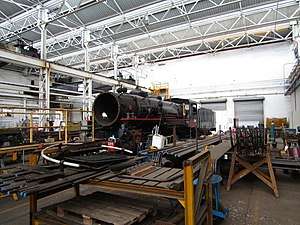Queensland AC16 class locomotive
The Queensland Railways AC16 class locomotive was a class of 2-8-2 steam locomotives operated by the Queensland Railways.
| Queensland Railways AC16 class | |||||||||||||||||||||||||||||||||||||||||
|---|---|---|---|---|---|---|---|---|---|---|---|---|---|---|---|---|---|---|---|---|---|---|---|---|---|---|---|---|---|---|---|---|---|---|---|---|---|---|---|---|---|
 AC16 221A pictured at the Ipswich Railway Workshops undergoing maintenance | |||||||||||||||||||||||||||||||||||||||||
| |||||||||||||||||||||||||||||||||||||||||
| |||||||||||||||||||||||||||||||||||||||||
| |||||||||||||||||||||||||||||||||||||||||
| |||||||||||||||||||||||||||||||||||||||||
History
World War II and the occupation by Japanese forces of Pacific Islands and islands to the north of Australia saw Queensland placed under the threat of imminent attack. This placed a great strain on Queensland Railway’s resources in the movement of wartime supplies and troops.
A request was made in 1941 for further, new C17 class locomotives and the specifications were forwarded to the United States where the United States Army Transportation Corps (USATC) drew up plans for a 2-8-2 with specifications similar to a C17 class, which became the USATC S118 Class. These locomotives were intended as a standard design for use on narrow gauge railways in other parts of the world as a wartime measure. Thus twenty engines obtained from the United States under Lend-Lease arrangements and later purchased. They were the only ones of their type to come to Australia out of a total of 741 similar engines built for USATC. They were unloaded in Sydney in 1943 and railed to Brisbane for assembly.[1][2][3][4]
Per Queensland Railway's classification system they were designated the AC16 class, C representing they had four driving axles, and the 16 the cylinder diameter in inches. Because the classification was already being used by an existing class they were designated American C16, i.e. AC16. The American steam locomotive earned it the nickname of Yank. The engines entered traffic with their US Army road numbers but had "A" appended to differentiate them from existing engines with the same numbers.[1][2]
The engines were supplied with conical profile tyres. These were altered to QR standard cylindrical profile and pressed one-sixteenth of an inch inwards on the wheels to reduce wear. In 1943 the decision was taken to alter the second and third coupled wheels to thin flanges. A number of other modifications were carried out over the years.
The engines were fitted with Walschaerts valve gear. The original tenders rode poorly and resulted in a speed limit of 30 mph being imposed with a prohibition on passenger train working. The axle load of these tenders also restricted the engines to main line usage. The floor level shovelling plate made the fireman's work more difficult. One feature that did proved popular was the use of louvre coal boards and these subsequently became standard on all QR steam engines. The headlight mounted on the smokebox door proved to have advantages and was later adopted for some other classes.[2]
In 1958, No. 217A was fitted with a tender taken from a withdrawn C16 class locomotive. The previous restrictions were then lifted. All 19 members of the class then remaining in service had been similarly treated by 1963.[1][2]
After being fitted with these tenders, seven of the class was attached to Alpha where they had a brief period of glory in the early 1960s when they replaced the C17 Class hauling the air-conditioned Midlander between Alpha and Longreach. The American engines with a larger boiler capacity were able to reduce running times in the sections that contained many long banks. Diesel locomotive took over the working in 1963.
Preservation
Two have been preserved:
- 218A at the Zig Zag Railway, Lithgow, under mechanical overhaul[5]
- 221A at the Workshops Rail Museum, restored to working order in 2003[6]
References
- Armstrong, John (1994). Locomotives in the Tropics Volume 2. Brisbane: Australian Railway Historical Society. pp. 102–108. ISBN 9780909937263.
- Turner, Jim (1997). Australian Steam Locomotives 1896-1958. Kenthurst: Kangaroo Press. p. 127. ISBN 086417778X.
- Oberg, Leon (2010). Locomotives of Australia 1850s-2010. Dural: Rosenberg Publishing. pp. 224/225. ISBN 9781921719011.
- Clark, Peter (2012). An Australian Locomotive Guide. Rosenberg Publishing. p. 73. ISBN 9781921719554.
- AC16 218A Australian Steam
- AC16 221A Australian Steam
Tourret, R. (1995). Allied Military Locomotives of the Second World War. Abingdon, Oxon: Tourret Publishing. ISBN 0-905878-06-X.